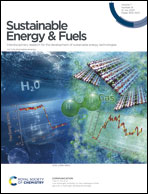Ruthenium–rhenium and ruthenium–palladium supramolecular photocatalysts for photoelectrocatalytic CO2 and H+ reduction†‡
Abstract
Photoelectrocatalysis offers the opportunity to close the carbon loop and convert captured CO2 back into useful fuels and feedstocks, mitigating against anthropogenic climate change. However, since CO2 is inherently stable and sunlight is a diffuse and intermittent energy source, there are considerable scientific challenges to overcome. In this paper we present the integration of two new metal–organic photocatalysts into photocathodes for the reduction of CO2 using ambient light. The two molecular dyads contained a rhenium carbonyl or palladium-based catalytic centre bridged to a ruthenium bipyridyl photosensitizer functionalised with carboxylic acid groups to enable adsorption onto the surface of mesoporous NiO cathodes. The photocathodes were evaluated for photoelectrochemical reduction of CO2 to CO or H+ to H2 and the performances were compared directly with a control compound lacking the catalytic site. A suite of electrochemical, UV-visible steady-state/time-resolved spectroscopy, X-ray photoelectron spectroscopy and gas chromatography measurements were employed to gain kinetic and mechanistic insight to primary electron transfer processes and relate the structure to the photoelectrocatalytic performance under various conditions in aqueous media. A change in behaviour when the photocatalysts were immobilized on NiO was observed. Importantly, the transfer of electron density towards the Re–CO catalytic centre was observed, using time resolved infrared spectroscopy, only when the photocatalyst was immobilized on NiO and not in MeCN solution. We observed that photocurrent and gaseous photoproduct yields are limited by a relatively low yield of the required charge-separated state across the NiO|Photocatalyst interface. Nonetheless, the high faradaic efficiency (94%) and selectivity (99%) of the Re system towards CO evolution are very promising.

- This article is part of the themed collections: Recent Open Access Articles, Sustainable Energy & Fuels Recent HOT Articles and Spotlight on Women in Energy


 Please wait while we load your content...
Please wait while we load your content...